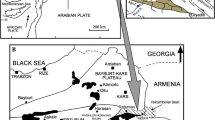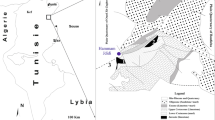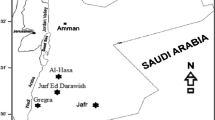Abstract
The Aydıncık tufa crops out in an area of approximately 1 km2 along the Mediterranean coast of Aydıncık town (Mersin-Turkey) located at the southern flank of the central Taurus mountain belt comprising clastics and carbonates ranging from Late Proterozoic to middle Eocene and several NE-SW aligned faults. It comprises seven texturally different facies: phytoherm framestone facies, phytoherm boundstone facies, micritic tufa facies, crossbedded carbonate sandstone facies, carbonate-coated conglomerate facies, pebbly carbonate sandstone facies, and tufa breccias facies. Of these, the phytoherm framestone facies and the phytoherm boundstone facies were deposited at the peripheral part of lake, whereas the micritic tufa facies toward the lake depocenter. Tufa breccias facies and crossbedded carbonate sandstone facies were resulted from erosion and redeposition of fragments from previously formed units such as phytoherm framestone and boundstone by fluvial activities developed within the environment. The tufa samples are composed of low-Mg calcite, and the terrigenous material in all tufa facies is generally very low. C and O isotop data show that the deposition of the Aydıncık tufa took place under cold water condition. The sedimentological and mineralogical characteristics of the facies points that the Aydıncık tufa was deposited in a fluvio-lacustrine environment in which the terrigen input was very low and was feeded by water from springs developed along the faults close to the Aydıncık tufa.











Similar content being viewed by others
References
Andrews JE (2006) Palaeoclimatic records from stable isotopes in riverine tufa: synthesis and review. Earth Sci Rev 75:85–104
AndrewsJE Pedley HM, Dennis PF (2000) Palaeoenvironmental records in Holocene Spanish tufas: a stable isotope approach in search of reliable climatic archives. Sedimentology 47:961–978
Arenas C, Gutierrez F, Osàcar C, Sancho C (2000) Sedimentology and geochemistry of fluvio-lacustrine tufadeposits controlled by evaporate solution subsidence inthe central Ebro Depression, NE Spain. Sedimentology 47:883–909
Chafetz HS, Folk RL (1984) Travertines: depositionalmorphology and bacterially constructed constituents. J Sed Petrol 54:289–316
FordTD PedleyHM (1996) A review of tufa and travertine deposits of the world. Earth Sci Rev 41:117–175
Gandin A, Capezzuoli E (2008) Travertine versus calcareous tufa:distinctive petrologic features and stable isotopes signatures. Ital J Quat Sci 21(1B):125–136
Glover C, Robertson AHF (2003) Origin of tufa (cool-water carbonate) and related terraces in the Antalya area, SW Turkey. Geol J 38:329–358
Hancock PL, Chalmers RML, Altunel E, Cakir Z (1999) Travitonics: using travertines in active fault studies. J Struct Geol 21:903–916
Heimann A, Sass E (1989) Travertines in the northern Hula Valley, Israel. Sedimentology 36:95–108
Horvatincic N, Bronic IK, Obelic B (2003) Differences in the 14C age, δ13C and δ 18O ofHolocene tufa and speleothems in the Dinaric karst. Palaeogeogr Palaeocl 193:139–157
Koç H, Özer E, Özsayar T (1997) Geology of Aydıncık (İçel) area. Yerbilimleri (Geosound) 30:417–427 (In Turkish with English abstract)
Koşun E (2012) Facies characteristrics and depositional environments of Quaternary tufa deposits, Antalya, SW Turkey. Carbonates Evaporites 27:269–289
Koşun E, Sarıgül A, Varol B (2005) Antalya tufalarının litofasiyes özellikleri. MTA Dergisi 130:57–70 (In Turkish)
Ordónẽz S, del Cura MAG (1983). Recent andTertiary fluvial carbonates in Central Spain. In: Collinson JD, Lewin J (eds) Ancient and modern fluvial systems, international association sedimentology, special publication, vol 6, pp 485–497
Özkul M, Gökgöz A, Sandor K, Baykara MO, Shen C-C, Chang Y-W, Kaya A, Hançer M, Aratman C, Taylan A, Örü Z (2014) Sedimentological and geochemical characteristics of a fluvialtravertine: a case from the eastern Mediterranean region. Sedimentology 61:291–318
Pedley HM (1990) Classification and environmental models of cool freshwater tufas. Sediment Geol 68:143–154
Pedley HM (2009) Tufas and travertines of the Mediterranean region: a testing ground for freshwater carbonate concepts and developments. Sedimentology 56:221–246
Pedley M, Ordónẽz S, Gonzalez-Martin JA, Garcia del Cura MA (1996) Does climate control the morphologicalfabric of freshwater carbonates? A comparative study ofHolocene barrage tufas from Spain and Britain. Palaeogeogr Palaeoclimatol Palaeoecol 121:239–257
Pedley HM, Martin JAG, Delgado SO, Garcia Del Cura MA (2003) Sedimentology of quaternary perched springline and paludal tufas: criteria for recognition, with examples from Guadalajara Province, Spain. Sedimentology 50:23–44
Pentecost A (2005) Travertine. Springer, Berlin, p 445
PortmanC Andrews JE, Rowe PJ, Leeder MR, Hoogewerff J (2005) Submarine- spring controlled calcification and growth of large Rivularia bioherms, Late Pleistocene (MIS 5e), Gulf of Corinth, Greece. Sedimentology 52:441–465
Acknowledgments
We are grateful to the Selcuk University Research Fund for their support (Project No: SÜ-BAP-08201009) for the financial support. Special thanks go to Prof.Dr. Levent ZOROĞLU from Department of Archeology, Selçuk University for introducing us the Aydıncık Tufa and for his logistic support in the field studies. This article is produced from Master Thesis of Fethiye (KÖSE) KALAN supervised by Hükmü ORHAN.
Author information
Authors and Affiliations
Corresponding author
Rights and permissions
About this article
Cite this article
Orhan, H., Kalan, F. Sedimentological characteristics of Quaternary Aydıncık tufa (Mersin-Türkiye). Carbonates Evaporites 30, 451–459 (2015). https://doi.org/10.1007/s13146-015-0244-7
Accepted:
Published:
Issue Date:
DOI: https://doi.org/10.1007/s13146-015-0244-7




